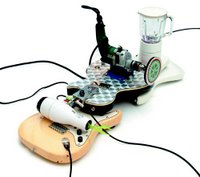
On Sunday I took a little time out from the extraordinary sunshine outside to have a look at what the Sydney Biennale had brought to Artspace in Woolloomooloo.
Tokyo artist Unjino Muneteru takes ordinary objects such as a hairdryer, juicers, an old wooden-housed radio, lamps and even a 1984 Ford Falcon and hooks them up to turntables to create music. The piece is entitled 'The Rotators." According to the little brochure accompanying the Biennale, "The work is based on the fact that most electronically-controlled products function/operate through rotation." (p.25) The turntables in this installation were playing records incised with pencil ends, which in turn triggered various other sound and lighting effects amongst the objects. The whole effect is a bit like what you would imagine might happen if the ordinary household objects that surround us came alive when we weren't around. A bit like an artist's Toy Story. It is a slightly surreal installation - the 'music' a vaguely hypnotic collection of simple rhythms and sounds. My companion noted the parallel with other works in the same vein - such as the group "From Scratch" which also used everyday and unlikely things (including natural materials) to create unusual sound performances. (see http://www.sonicsfromscratch.co.nz/fromscratch.php) Music and sound intersecting with 'trash art' or art that incorporates found objects is alive and well it seems in the work of Unjino.
There are a couple of quirky pieces by Jose Damasceno on display which also incorporate found objects, and a series of photographs from France by Finnish artist Elina Brotherus.
The video work of Tacita Dean is a little less fathomable and accessible to the audience. Tacita Dean's video piece prompted frustration from a viewer nearby who exclaimed, "if they could just provide some explanations!" Encountering a work such as this for the first time without any idea as to the background of the artist and their intentions in creating the work is somewhat bewildering. One has to ask the question - if the work fails to communicate something to viewers without an explanation handy then is it failing on a fundamental level? Video and performance art in particular often suffers from this lack of engagement and ability to communicate with a wider audience.
Here is what the Artspace website had to say about the work by Tacita Dean:
"British-born, Germany-based artist Tacita Dean will exhibit her moving film Boots, 2003. Boots is filmed in the Casa de Serralves, Porto, Portugal. Dean asked a family friend, the architect Robert Steane, affectionately known as ‘Boots’, to wander through the rooms of the Casa. The film is made in three versions of 20 minutes duration in English, French and German. Exhibited separately, each version shows ‘Boots’ entering a different façade and, as if inhabited by the memory of the space, speaks to the passing of human lives and the aspirations they embodied".
Well I think I will leave the explanation at that juncture and perhaps go delving into the problems of performance and video art in more detail on less sunny day!

No comments:
Post a Comment